How to properly create a children's wardrobe: tips for mothers. What is included in a basic children's wardrobe?
Larisa Knopkina | 3.08.2015 | 7776Larisa Knopkina 08/3/2015 7776
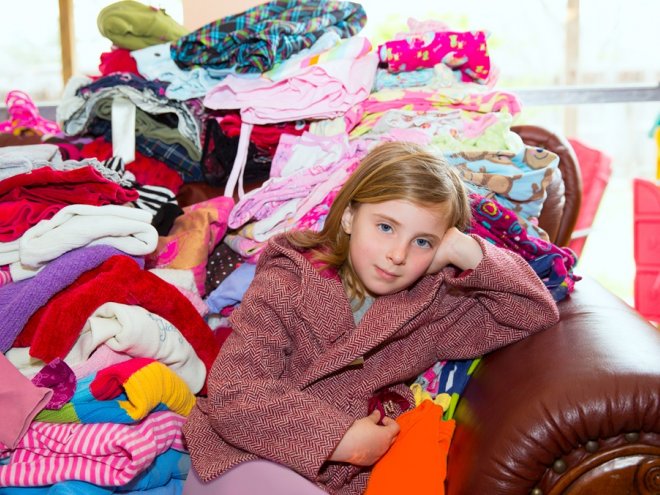
What should be in a child's wardrobe? Finding out how to choose the right clothes and don't buy too much.
Previously, my nine-year-old daughter Vera had a lot of clothes that cluttered her closet. She didn’t wear half of the clothes at all: she quickly outgrew some of the dresses, and she didn’t have a suitable top for two skirts. In general, the clothes are for children, but the problems are for adults.
One day I came across one of the fashion programs where they talked about the basic wardrobe for a child. It should include things that can be intelligently combined with each other by changing childish image every day.
After the transfer, I decided to form such versatile wardrobe for Vera. In doing so, I was guided by three principles:
- so that there are no unnecessary things;
- so that wardrobe items match each other;
- so that the child has enough clothes and enough everything.
Clothes for children - what should be in the closet?
The list of basic children's wardrobe should include the following things:
1. Socks, tights, underwear. It is enough to have about 5 pairs of tights, 7 pairs of socks and about 5 sets of underwear, which include panties and a T-shirt. The latter must be sewn natural materials so that the baby's skin can breathe. As for socks and tights, it is advisable that they also be made of cotton. However, keep in mind that they will wear out and tear faster than synthetic ones.
2. Hats. It is optimal to have 2 hats in your wardrobe for the off-season and 2 hats for the winter (plus a warm scarf and mittens). In summer, you can’t go without a hat either - you can buy several panama hats made from natural materials in light colors.
3. Pants, jeans, shorts. During the off-season period, the child should have 4 pairs of trousers:
- jeans;
- classic pants;
- strokes;
- sports trousers.
As for summer, it is permissible to have three pairs (for boys) and one (for girls). These can be light breeches, shorts and trousers.
4.Dresses, sundresses (for girls). Instead of large quantity trousers, the little princess's wardrobe should be filled with dresses and sundresses. For spring and summer, two warm options are enough, but for summer you can stock up on 4 dresses.
5. T-shirts. A boy's basic wardrobe should have about 7 T-shirts made from natural fabrics.
6.Shirts and blouses. A boy needs to have about 3 shirts that he will wear under his trousers. And for a girl - 2-3 blouses under a skirt or sundress.
7.Sweaters and jumpers. This clothing is necessary for the off-season (4 cotton jumpers) and winter (2 sweaters with added wool).
8. Turtlenecks. Your basic wardrobe should include at least 2 turtlenecks, which can be combined with various things like skirts, jeans, sundresses.
Often parents commit typical mistakes regarding children's clothing: they buy an incredible amount of things that then gather dust in the closet; buy unnecessary things at sales; They make spontaneous purchases that do not “fit” with any item from the children’s wardrobe.
That's all, the basic wardrobe for a child has been compiled.
It's hard to argue with the fact that children wear the most fashionable and current clothes. And it’s not even a matter of parents’ desire to give their offspring the best, it’s just that children grow out of all their clothes so quickly that moms and dads have to renew them every season. children's wardrobe. Are there ways to do this with minimal losses for the family budget?
Clothes for kindergarten (school)
The basic wardrobe must necessarily include outfits that the child will wear to school or kindergarten, casual clothes, and tracksuits and shoes. When dressing your child for kindergarten, you need to take into account the possibility of weather changes. To do this, you should rely on layers of clothing. For these purposes, the baby’s wardrobe should have 3-4 T-shirts and a pair of turtlenecks different colors, several pairs of tights, warm and light trousers. In short, clothes for kindergarten should be comfortable, non-marking and functional. As for the school wardrobe, everything is simpler here. As a rule, today everything educational establishments insist that children wear a certain type of uniform. Parents should also worry about accessories. Both at school and in kindergarten, children will need children's backpacks, where they can put everything they need: books, toys and other children's “valuables”.
Casual wear
The main principle when choosing a children's wardrobe is the child's comfort. If adults often prefer to wear something that is not very comfortable, but fashionable clothes, then for kids this approach when choosing things is unacceptable. A standard set of clothes for a child should include:
- 3-4 turtlenecks;
- 3 warm sweaters;
- 3-4 pairs of trousers (skirts for girls);
- light jacket;
- winter jacket or overalls;
- several hats (autumn and winter);
- several pairs of shoes for each season.
Experts advise having 6-7 units of underwear and tights (underpants) (for each day of the week) so as not to embarrass yourself with everyday washing. Parents of girls should not forget about accessories, such as hairpins, elegant hoops, and children's handbags. For boys, the main aspect should be practicality. For example, trousers made of waterproof material would be very appropriate among a tomboy's clothes. thick fabric, in which he can safely walk through puddles.
As a rule, the wardrobe of most modern children much more than is necessary. But often parents, in an effort to dress their baby as smartly as possible, forget that the child does not need 25 blouses and 50 skirts. It would be much wiser to create a small, but at the same time properly composed and high-quality children's wardrobe.
August 27, 2015, 11:19 pm
I want to talk about a child’s wardrobe, what problems may arise in implementing this issue, and also list the approximate minimum clothing that a baby under the age of one year should have.
The times of shortages of goods are long gone, so today no child will be left undressed or half-dressed. It seems to me that modern parents with completely different levels of income can create a pretty decent wardrobe for their little one, which will contain all the necessary things, even if not from world brands.
The main danger is that the range of children's clothing today is so large, varied and pleasing to the eye with its abundance of colors and models that you definitely want to buy everything. The situation is aggravated by the fact that numerous grandmothers, grandfathers, aunts and uncles strive to give their pet not only a toy, but also some cute clothes at every visit. As a result, it turns out that there are no closets in the house for just one children's clothing. But here adults very often forget or cannot adequately evaluate one important point: Children grow up very quickly! Many times already I have heard complaints from my friends and acquaintances that when clearing out shelves in closets with children's clothes, they invariably encounter a situation where half or the nth part of the cute, stylish children's things were never able to be worn while they were still in stock. to size. Of course, it is not necessary to throw it away, you can give it away to friends, give it to orphanages, BUT, probably, if you calculate how much money you can save from this item of family expenses, you will gasp. Moreover, children's clothes today are not as cheap as we would like.
In order to direct the situation in a rational direction, it would not hurt to spend a small amount of time to sit down, think and determine the necessary minimum of what your child needs. As a supporter of all lists, I advise you to make a list for this issue. When it is in front of your eyes, you will have a clear idea of what to buy and what not to spend money on. In addition, knowing what your child needs, you can guide grandparents and relatives in their gifts, if, of course, they consult with you about this. (In my practice, many of my friends simply do not hesitate to ask what to give to the baby).
It is clear that at different age periods the baby’s basic wardrobe will change, and there cannot be any universal option for all the time. In this material, based on my own experience, I will try to present you with a list of things basic wardrobe for a baby from 0 to 1 year old.
First, some general tips on what clothes should be for children of this age and how to choose them.
Firstly, main criterion choice - quality, no matter how attractive all sorts of ruffles, overhead designs, bright colors, they cannot be given priority. Only natural fabrics, pastel shades, fewer inconvenient fasteners, overlay patterns that can create discomfort. In general, a child should feel as comfortable and comfortable as possible in these clothes.
Secondly, it is important to maintain a balance of quantities. Now I’ll explain what I mean. A child at this age needs a lot of clothes, because even at home he will have to change them many times a day, despite the fact that he is not yet moving very actively: he smeared himself with food, had an unsuccessful trip to the toilet, poured something like that on himself There are countless “dangers”. Therefore, there should be enough clothing, but you shouldn’t go too far either.
Third, I have more than once encountered situations where, in an excessive pursuit of savings, parents buy clothes for their children to grow into. Of course, such an option is absolutely acceptable, but within reason. Some children's clothes even have special cuffs, with the use of which the suit or pants will fit after a certain period of time and will not greatly restrict the baby's movements. But I have observed when they try to wrap one-year-old children in a jacket for a three-year-old baby, rolling up the sleeves almost to the shoulders and making him into a clumsy penguin, who already doesn’t stand confidently, and in a jacket that doesn’t fit, generally falls on his side at the slightest slight. blowing wind. In general, here we are also guided by the rule - everything is good when in moderation. It is clear that during this age period the baby is growing very actively and the wardrobe will have to be updated after 3 months, closer to six months, and then to a year, but, nevertheless, the general basic list It is still possible to compose.
1.Baby undershirts. No matter what time of year your baby was born, you will need thin and warm onesies. The minimum will be enough 5 pieces of light and 5 pieces of flannelette. Naturally, as the year approaches, this item of clothing is eliminated and replaced with T-shirts of varying thickness, which have buttons on the shoulder for ease of dressing.
2.Bodysuit. This is a thing similar to a sweater, only it is long enough to fasten it with buttons on the crotch. They can be with short or long sleeves, thick or thin. For me, it is very functional and handy item wardrobe for the baby, since his back and tummy are constantly closed, the bodysuit does not crumple, does not unfasten, or creep up. By the way, bodysuit sizes are very different. You can also find them for a baby who more than a year. You can limit the number of bodysuits in your wardrobe 5 pieces.
3.Sliders. For a baby closer to one year of age, you can replace them with tights - 5-8 pieces. The quantity by density depends on the season. In summer, thin ones predominate; in winter, flannelettes predominate. Naturally, if you and your baby do not use diapers, then there should be more rompers and tights.
4.Thin overalls. I don’t mean street options, but fabric, flannel or cotton ones that are worn at home. Like bodysuits, they seem to me to be a very comfortable, functional piece of clothing: due to the buttons along the entire length or on the hangers, they are very easy to put on, they also do not creep, do not bunch up, the baby is securely packed in them. 3-5 will be sufficient. Leave 1 or 2 of them in case you leave home: on a visit, to the clinic, so that they are in presentable condition. Also choose the material according to the season.
5.Two Piece Suits. For babies from 0 to one year, these sets are very inconvenient, but it doesn’t hurt to have a couple in your wardrobe. For boy - 2 suit For a girl, at this point you can purchase a suit consisting of a skirt/jacket and a dress.
6.Socks. Thin – 3 pairs, warm – 1 pair.
7.Hats and caps. Caps: 2 pieces of thin cotton, 2 pieces of flannelette. Hats: 1 thick, insulated hat for the winter, 1 thinner but warm for the mid-season, 1 or 2 caps with a visor or Panama hats for the summer.
8.Sweatshirts and sweaters- 3 pieces. They should be different in density: one is not very dense, the second is somewhat denser, the third is warm.
9.Mittens and scratches. 2 pieces of special thin mittens, which are called “scratchers”, they are needed until about 3 months, so that the baby does not scratch himself with his own hands during chaotic, unbalanced movements. 1 warm mittens for walking outside.
10.Panties. I mean options that can be worn for going outside or for going to all sorts of public places or guests. 2 pieces for boys, skirt and pants for girls.
12. Walking overalls- 1 piece. In the overwhelming majority, they are suitable for winter use.
13. Jackets- 1 demi-season, 1 – thin in the form of a raincoat on warm spring and cold summer.
As for shoes, a baby who has not started walking does not need them at all. For walking outside, special warm booties and socks are usually used, or some overalls are sewn in such a way that they have a compartment for the feet and do not require shoes. As the year approaches, it won’t hurt to get slippers, 2 pairs of summer shoes, and 1 pair of winter and demi-season shoes.
It is clear that this list is quite approximate and can vary, both in the combination of items and in their number. But, nevertheless, having such a list of children's clothing, you will be able to avoid wasteful spending and will not fill your closets with unnecessary things
Please write in the comments under the topic if you have similar lists of children's wardrobes. In addition, if you can somehow supplement or correct my list, I will be glad to hear these comments and additions.
For most babies and their mothers, summer is a long-awaited time. After all, all people, without exception, associate this time of year with exciting adventures, long journeys, meetings with friends and relatives in an informal setting, as well as new acquaintances and unexpected discoveries.
Summer weather requires the presence of an appropriate wardrobe that will allow the baby’s body to be in conditions of thermal comfort, breathe and be protected from direct exposure to the ultraviolet spectrum sun rays.
Despite the fact that children’s summer clothes are most often used only for one season, their choice should be approached responsibly, giving preference to practical and at the same time high-quality models.
Before you start replenishing your children's wardrobe for the summer, you need to mentally identify three main groups of things: for hot and cool weather, as well as for rainy days. Ideally, each group should be represented by at least four sets for daily wear and one “going out” outfit.
In the summer heat, you can’t do without T-shirts, which should be bright and with life-affirming prints. It is desirable that they go well with basic things wardrobe, looked good on the baby and had a natural composition. The inclusion of no more than twenty percent artificial fiber is acceptable. Natural cotton fabrics have faithfully served humanity for many years, providing optimal conditions for heat exchange and protecting against unwanted exposure to ultraviolet rays.
As for the main color of T-shirts, despite the soiling, preference should still be given to products made from white fabric, as this indicates the absence of dyes and also guarantees that most of the sun's rays will be reflected from its surface. Psychologists insist on excluding aggressive and toxic colors from a child’s wardrobe, since this can negatively affect the mental state of a child who is constantly under the influence of such color combinations.
For babies in the first years of life, bright bodysuits with short and long sleeve much preferable to T-shirts. They will provide them with the necessary comfort during a walk, relieve their mother from unnecessary worries and guarantee impeccable appearance under any circumstances.
In addition to T-shirts, the clothing group for hot days should include several shirts with short sleeve for boys and several blouses with puff sleeves for girls. Shirts from natural fiber will provide no less comfortable conditions for the baby’s heat exchange than T-shirts, but at the same time, they will introduce an element of style into his wardrobe and become a kind of indicator of adulthood. Among other things, the shirt will be a powerful incentive for development fine motor skills, because everyone will want to learn how to fasten buttons on their own, like dad or mom does. Light blouses for girls can be safely combined with a sundress, shorts, trousers and a skirt, creating new outfits and gradually introducing the baby to the basics of fashion and practicality.
In hot weather, both girls and boys simply cannot do without shorts, which today are made in various lengths and allow each child to choose exactly the option that suits them best. The material for them should also be natural or predominantly natural, and the colors should be chosen universal, which will allow you to achieve perfect combinations with everyone additional elements wardrobe Ideally, it is advisable to purchase short and long shorts, as well as breeches for both boys and girls, to whose wardrobe it would be a good idea to add tight-fitting cropped leggings.
Babies who go out for walks in diapers will not do without overalls, and for older babies you should purchase several pairs of light trousers made of cotton fabric. The group of clothing items for hot days is completed by a cap or panama hat, which should be replaced by a bandana for boys and a bright scarf with a visor for girls.
Cooler days require appropriate changes in clothing. In such weather conditions, the baby can wear thick long trousers, a golf shirt, a sweatshirt or a light sweater, and for extremely cold weather a denim jacket or windbreaker should be provided. In such clothes you can safely go into nature, take trips on a yacht and begin your first ascents of the mountain.
For rainy days, you should have a waterproof raincoat or jacket with a special water-repellent impregnation, a bright umbrella, thick trousers, as well as rubber boots, which are now a fashionable accessory and give kids the opportunity to enjoy walking through puddles even in the presence of their mothers.
Don't forget about elegant sets, which, naturally, are not practical and require special treatment, but increase the confidence of the little ones in their irresistibility, and also cause undisguised delight and tenderness among others.
You can either write your own.
My child is equipped for the fall-winter. Perhaps all that remains is to find some warm mittens and leggings for very cold and wet weather, but otherwise there is something to wear.
Illustrations today will be from the phone, Instagram and the Internet, because... I’ve run out of trial Lightroom, but I can’t find an illegal and hacked one somewhere, please share, huh?
A windbreaker with a hood for warm weather, which probably won't happen anymore. I bought it at “Mama for Children” for 800 rubles, the size is quite close, so in the spring I’ll probably have to look for something new, although I really like it!
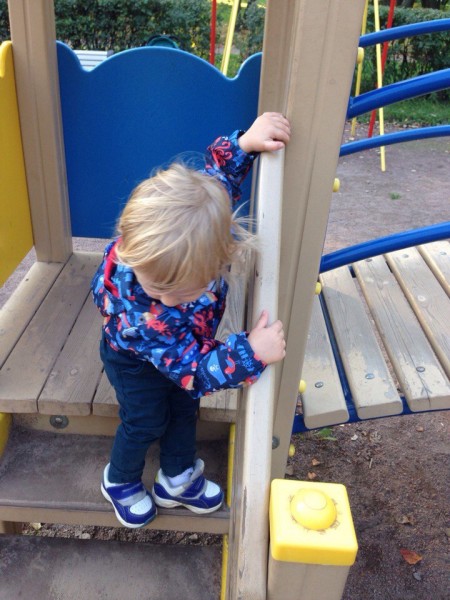
In the same photo you can see Caroch sneakers, which, I’m sure, perfectly reach 5-7 degrees with warm socks - in fact, Vera just wore Kotofeev’s sneakers this spring.
In very humid, cool weather, I insulated the child with a fleece blouse from Decathlon, and on top of everything I put on Finnish rubber pants (I bought them for 400 rubles from a friend in the spring, they accidentally brought pink ones for the boy), and on my feet - Luckyland rubber boots for 300 rubles from Okay ".
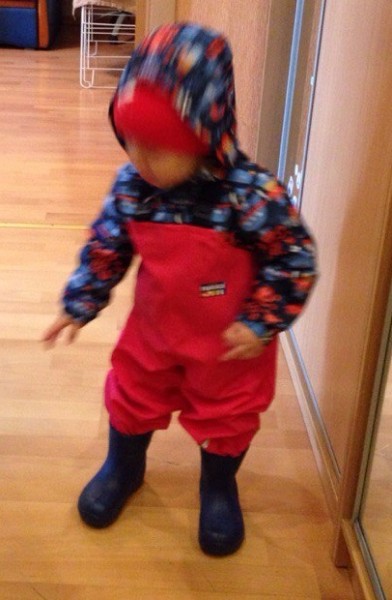
Given the current weather - noticeably cool and rainy - we have this coat. In general, it would be better, of course, some kind of demi-season jacket, but Vera was given the coat, it’s a close fit, so its only purpose is to last this fall and I won’t duplicate it with anything. Plus, it's very girly and cute.
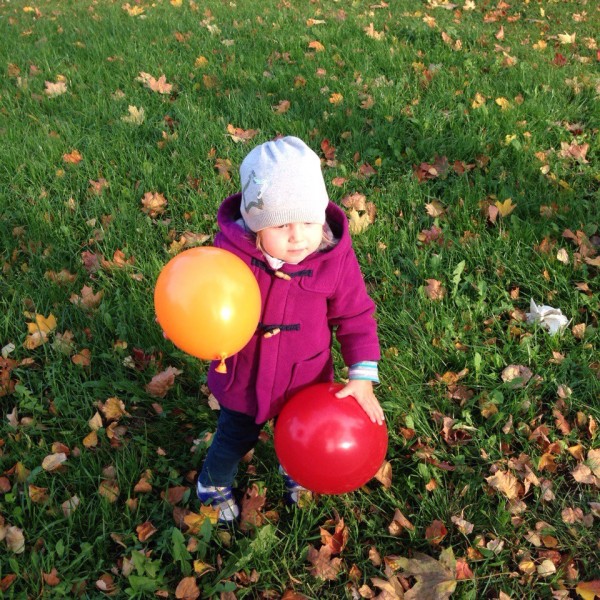
But if we’re talking about real mimimi and unyanyanya, then here’s another coat for you, this time made especially for Vera with a small reserve so that we can wear it in the spring.
I ordered it from@cat.in.a.coat , this is a small production of my husband’s cousin (or second cousin?) She herself is very stylish and dresses her five-year-old daughter incredibly coolly; she recently decided to start her own micro-business, sewing children’s clothes from good fabrics according to individual measurements. Our coat is made of very soft fabric with a silk lining, I would wear it myself!
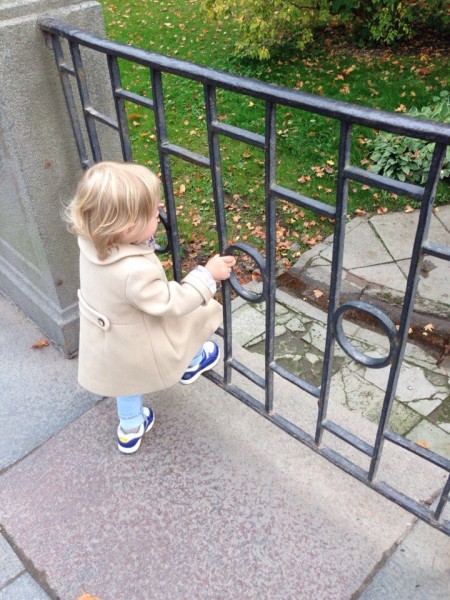
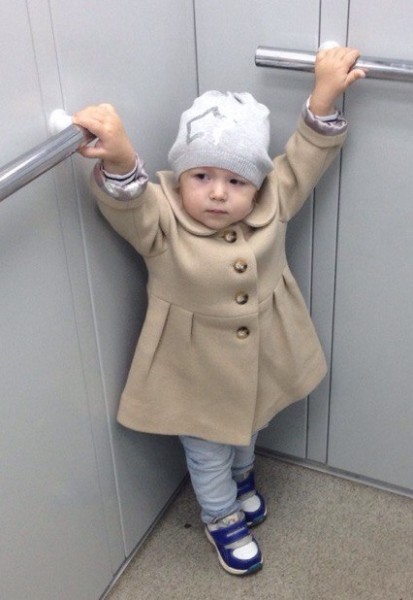
For now, Vera wears it with sneakers, but her hands are itching to buy more Chelsea boots like these at H&M. Well, won't it be cool?
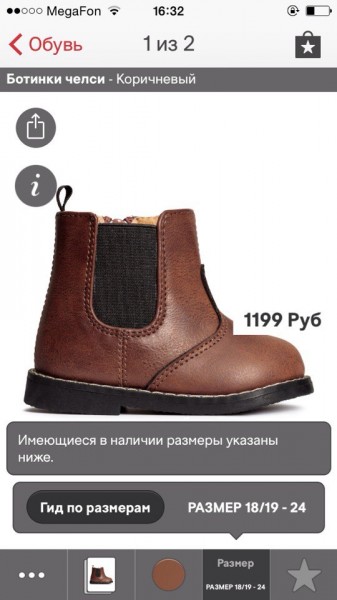
For the cold autumn and warm winter after terrible suffering and a fierce discussion in a post about how to dress a child on a budget for autumn-winter, I finally bought an uncompromisingly pink Lassie jumpsuit in size 86. There seems to be 180 grams of insulation, that is, taking into account the St. Petersburg climate and my dislike for walking, I think we spend almost the entire winter wearing it. If something happens, we will insulate ourselves with a Polartek underwear that was left over from last season.
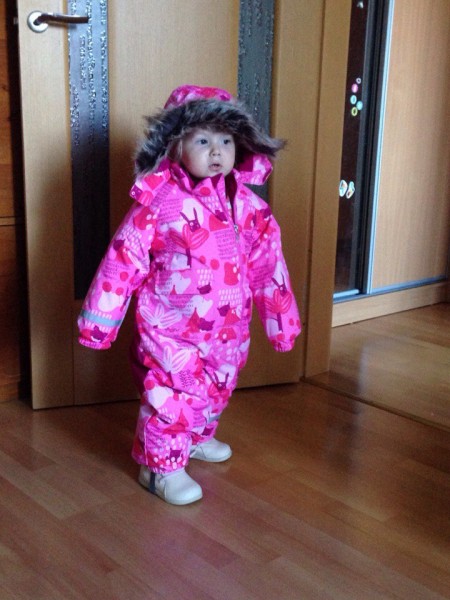
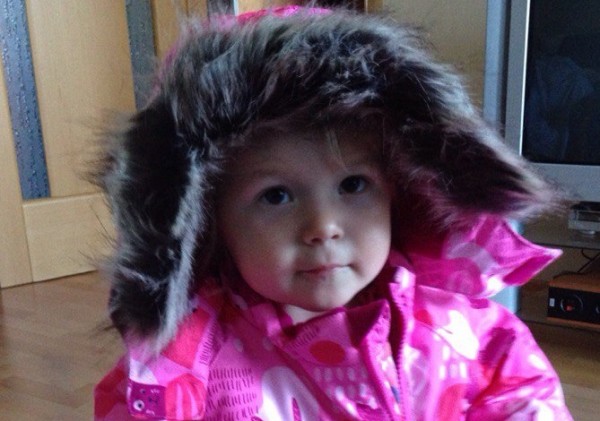
It comes with warm Little Blue Lamb boots with faux fur (you can see a little in the top photo with Vera). Follow the link - in a different color, ours is cream-colored with pale pink laces, purchased for the occasion in Instagram LBL for the cost of delivery, they sold shoes with a small defect. These boots, according to them, had paint on the top, but I never found where. By the way, here are our underwears.




